Abstract
In a prospective, randomized study, ceftazidime monotherapy was compared with a combination of ceftazidime and flucloxacillin in 100 febrile neutropenic patients. Thirty-four bacteriologically documented infections, of which 26 were bacteremias, in 51 patients were treated with ceftazidime alone. Thirty-four bacteriologically proven infections, of which 29 were bacteremias, in 49 patients were treated with a combination of ceftazidime and flucloxacillin. The clinical response rate for ceftazidime monotherapy was 80%; the bacteriological cure rate was 90%. Efficacy against gram-negative pathogens appeared to be excellent, achieving a 100% cure rate. The clinical response and bacteriological cure rates for the combination were 76 and 86%, respectively. Three superinfections were registered in the ceftazidime group, and four, involving six pathogens, were registered in the combination group. Other side effects of ceftazidime were minimal. It is concluded that ceftazidime is an effective drug for the empiric treatment of febrile neutropenic patients. It offers the opportunity to avoid the aminoglycosides in first-line treatment. It may be appropriate to combine ceftazidime with cephalothin or vancomycin or to modify therapy if resistant gram-positive strains are encountered.
Full text
PDF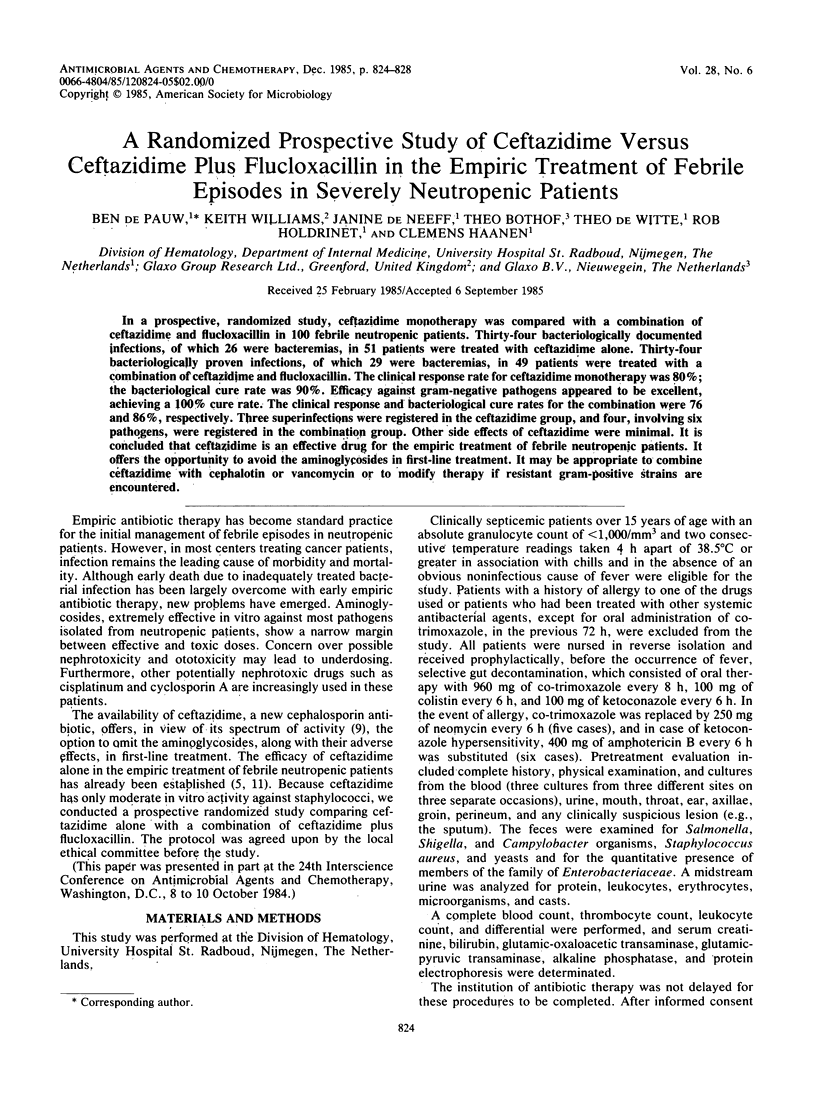
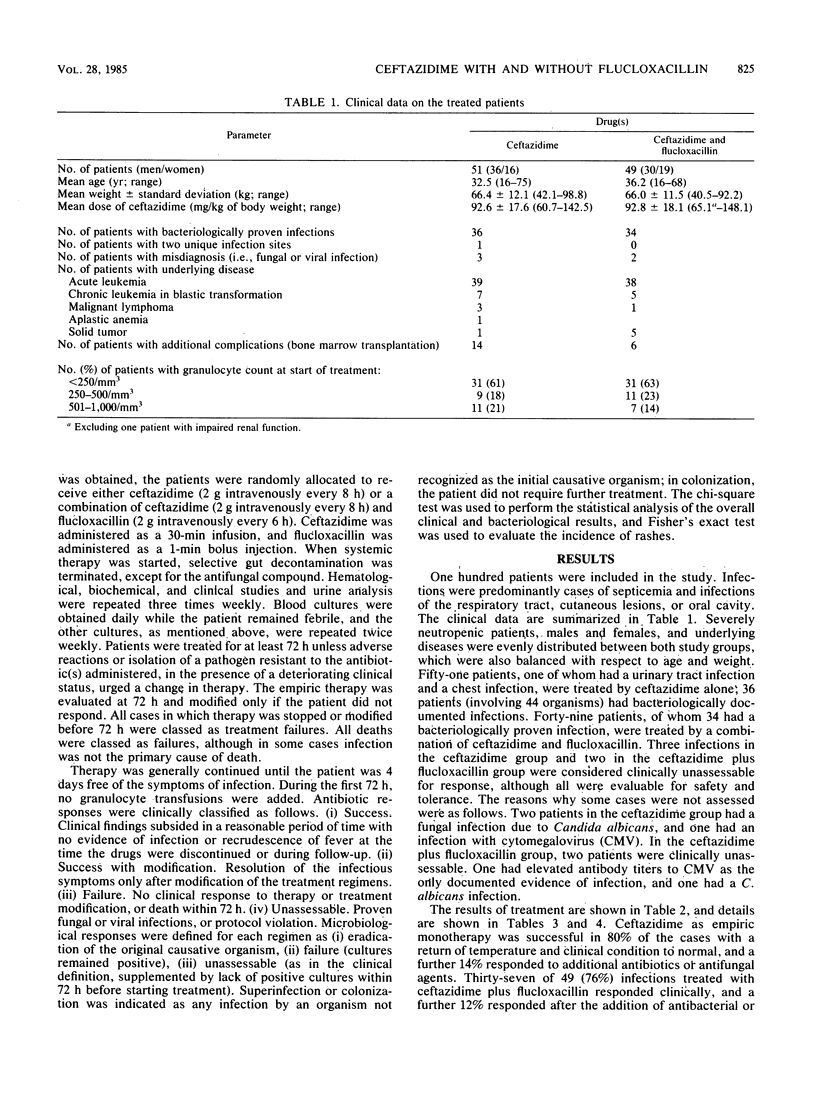
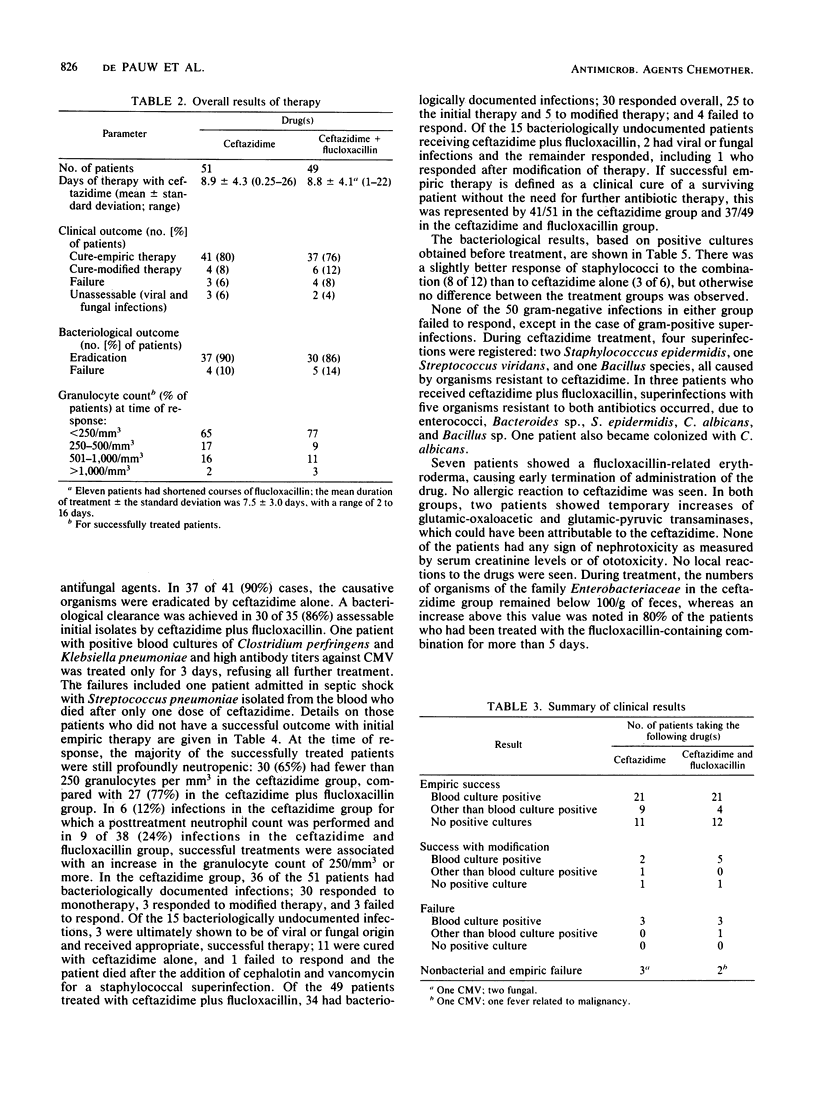
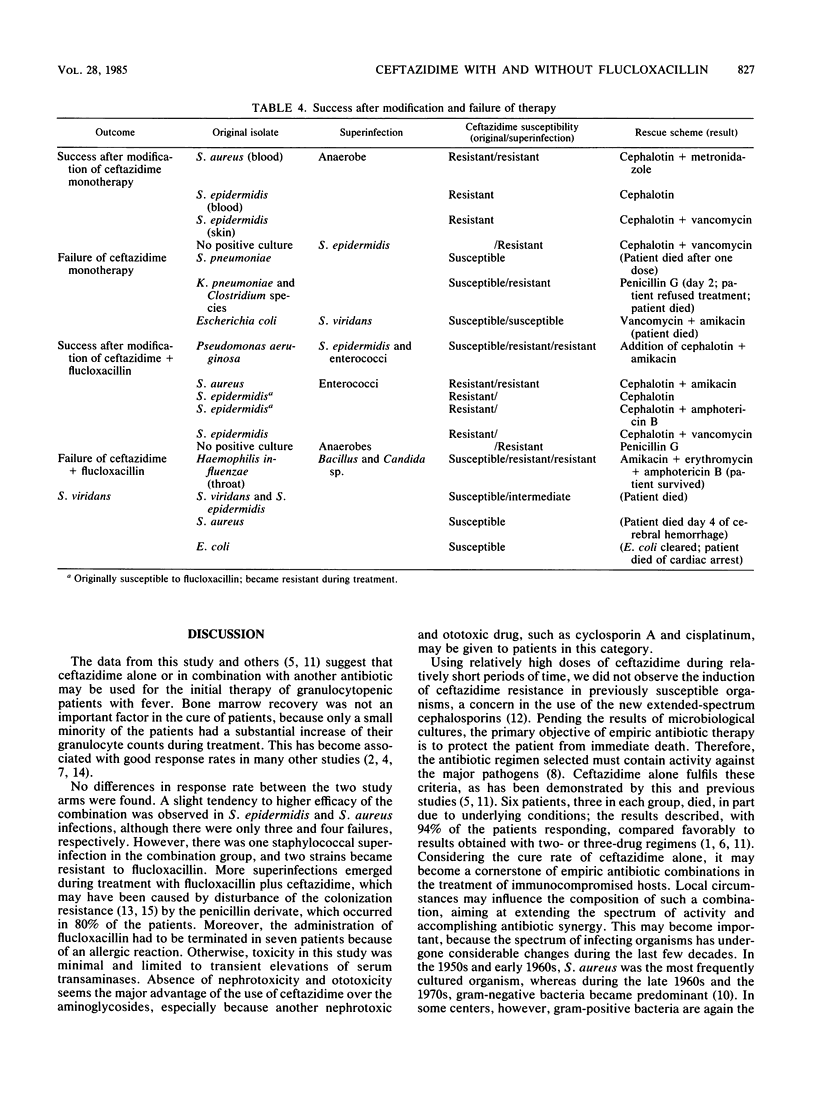
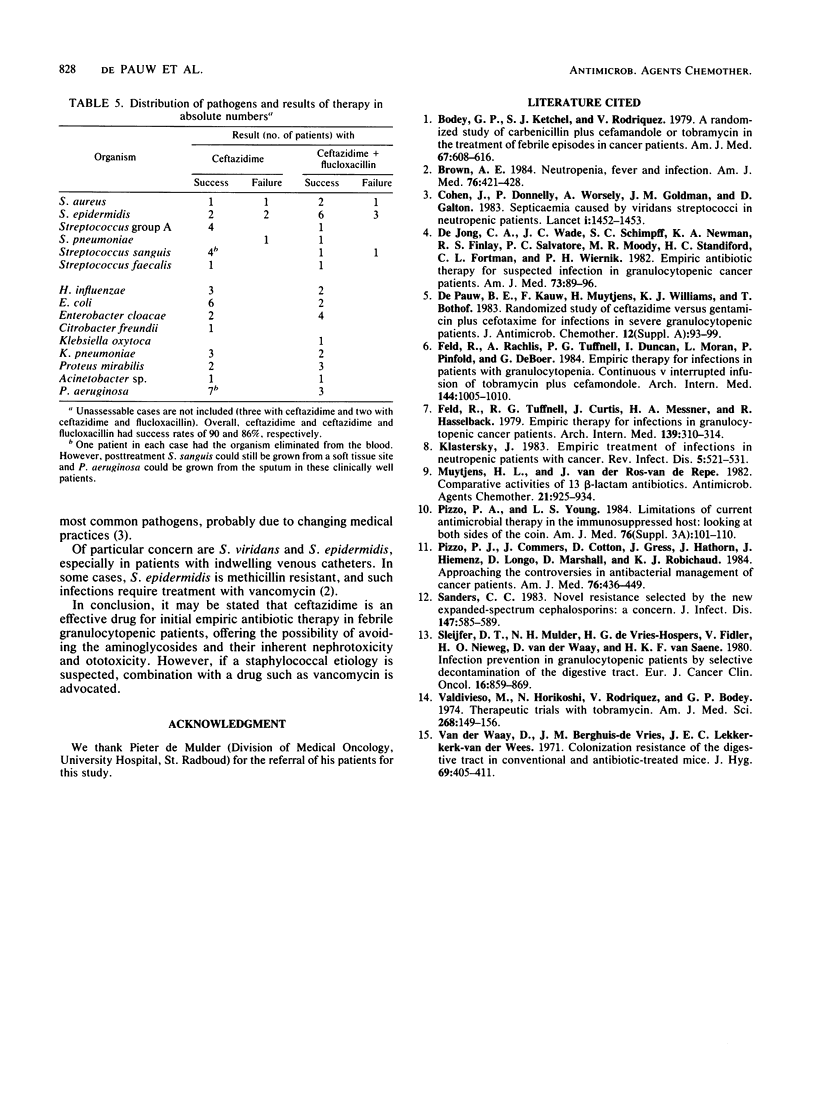
Selected References
These references are in PubMed. This may not be the complete list of references from this article.
- Bodey G. P., Ketchel S. J., Rodriguez V. A randomized study of carbenicillin plus cefamandole or tobramycin in the treatment of febrile episodes in cancer patients. Am J Med. 1979 Oct;67(4):608–616. doi: 10.1016/0002-9343(79)90242-0. [DOI] [PubMed] [Google Scholar]
- Brown A. E. Neutropenia, fever, and infection. Am J Med. 1984 Mar;76(3):421–428. doi: 10.1016/0002-9343(84)90661-2. [DOI] [PubMed] [Google Scholar]
- Cohen J., Donnelly J. P., Worsley A. M., Catovsky D., Goldman J. M., Galton D. A. Septicaemia caused by viridans streptococci in neutropenic patients with leukaemia. Lancet. 1983 Dec 24;2(8365-66):1452–1454. doi: 10.1016/s0140-6736(83)90799-7. [DOI] [PubMed] [Google Scholar]
- De Jongh C. A., Wade J. C., Schimpff S. C., Newman K. A., Finley R. S., Salvatore P. C., Moody M. R., Standiford H. C., Fortner C. L., Wiernik P. H. Empiric antibiotic therapy for suspected infection in granulocytopenic cancer patients: a comparison between the combination of moxalactam plus amikacin and ticarcillin plus amikacin. Am J Med. 1982 Jul;73(1):89–96. doi: 10.1016/0002-9343(82)90935-4. [DOI] [PubMed] [Google Scholar]
- Feld R., Rachlis A., Tuffnell P. G., Duncan I., Moran L., Pinfold P., DeBoer G. Empiric therapy for infections in patients with granulocytopenia. Continuous v interrupted infusion of tobramycin plus cefamandole. Arch Intern Med. 1984 May;144(5):1005–1010. [PubMed] [Google Scholar]
- Feld R., Tuffnell P. G., Curtis J. E., Messner H. A., Hasselback R. Empiric therapy for infections in granulocytopenic cancer patients: continuous infusion of amikacin plus cephalothin. Arch Intern Med. 1979 Mar;139(3):310–314. [PubMed] [Google Scholar]
- Muytjens H. L., van der Ros-van de Repe J. Comparative activities of 13 beta-lactam antibiotics. Antimicrob Agents Chemother. 1982 Jun;21(6):925–934. doi: 10.1128/aac.21.6.925. [DOI] [PMC free article] [PubMed] [Google Scholar]
- Pizzo P. A., Commers J., Cotton D., Gress J., Hathorn J., Hiemenz J., Longo D., Marshall D., Robichaud K. J. Approaching the controversies in antibacterial management of cancer patients. Am J Med. 1984 Mar;76(3):436–449. doi: 10.1016/0002-9343(84)90663-6. [DOI] [PubMed] [Google Scholar]
- Pizzo P. A., Young L. S. Limitations of current antimicrobial therapy in the immunosuppressed host: looking at both sides of the coin. Am J Med. 1984 Mar 30;76(3A):101–110. doi: 10.1016/0002-9343(84)90327-9. [DOI] [PubMed] [Google Scholar]
- Sanders C. C. Novel resistance selected by the new expanded-spectrum cephalosporins: a concern. J Infect Dis. 1983 Mar;147(3):585–589. doi: 10.1093/infdis/147.3.585. [DOI] [PubMed] [Google Scholar]
- Sleijfer D. T., Mulder N. H., de Vries-Hospers H. G., Fidler V., Nieweg H. O., van der Waaij D., van Saene H. K. Infection prevention in granulocytopenic patients by selective decontamination of the digestive tract. Eur J Cancer. 1980 Jun;16(6):859–869. doi: 10.1016/0014-2964(80)90140-1. [DOI] [PubMed] [Google Scholar]
- Valdivieso M., Horikoshi N., Rodriguez V., Bodey G. P. Therapeutic trials with tobramycin. Am J Med Sci. 1974 Sep;268(3):149–156. doi: 10.1097/00000441-197409000-00003. [DOI] [PubMed] [Google Scholar]
- de Pauw B. E., Kauw F., Muytjens H., Williams K. J., Bothof T. Randomized study of ceftazidime versus gentamicin plus cefotaxime for infections in severe granulocytopenic patients. J Antimicrob Chemother. 1983 Jul;12 (Suppl A):93–99. doi: 10.1093/jac/12.suppl_a.93. [DOI] [PubMed] [Google Scholar]
- van der Waaij D., Berghuis-de Vries J. M., Lekkerkerk Lekkerkerk-v Colonization resistance of the digestive tract in conventional and antibiotic-treated mice. J Hyg (Lond) 1971 Sep;69(3):405–411. doi: 10.1017/s0022172400021653. [DOI] [PMC free article] [PubMed] [Google Scholar]


